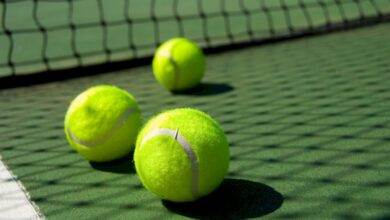Are you ready to take your game to the next level with pickleball? Whether you’re a beginner just starting or looking to improve your skills, this article is here to help you get started on the right foot. So let’s dive in and discover the thrilling world of pickleball together!
Pickleball Equipment and Court Layout
To get started with pickleball, you’ll need the right equipment and an understanding of the court layout. Pickleball is typically played on a court that is similar in size to a badminton court, with a few key differences. The court is divided into two halves by a net that is similar to a tennis net. Each half of the court is further divided into three sections: the kitchen, the non-volley zone, and the baseline. The kitchen is a 7-foot area on both sides of the net where players are not allowed to volley the ball. The non-volley zone is the area between the kitchen and the net, and players are not allowed to step into this zone to volley the ball. The baseline is the area at the back of the court where players serve and receive the ball. Now, let’s move on to the equipment you’ll need to play pickleball.
When it comes to equipment, the most important item you’ll need is a pickleball paddle. Pickleball paddles are similar in shape to ping pong paddles, but they are larger and have a solid surface. The paddle is used to hit the pickleball, which is similar to a wiffle ball but slightly smaller. Also, make sure to consider factors such as weight, grip size, and material.
Basic Rules and Scoring of Pickleball
Before you step onto the pickleball court, it’s important to familiarize yourself with the basic rules and scoring of the game. Pickleball can be played in singles or doubles, but for beginners, it’s recommended to start with doubles to get a feel for the game. The game begins with a serve, which must be made underhand and diagonally across the net. The serve must land within the opposite diagonal court and clear the non-volley zone. If the serve is unsuccessful, it’s called a fault, and the serve is given to the opposing team. Once the serve is successful, the receiving team must let the ball bounce once before returning it. After the ball has bounced, both teams can volley the ball or let it bounce once before returning. The game continues until a team fails to return the ball, hits the ball out of bounds, or commits a fault. Points are scored only by the serving team, and games are typically played to 11 or 15 points, with a two-point advantage.
Pickleball Techniques and Strategies for Beginners
To excel at pickleball, it’s important to master the fundamental shots and develop effective strategies. The most basic shot in pickleball is the dink, which is a soft shot that is hit from the non-volley zone close to the net. The dink is used to keep the ball low and force your opponents to hit up, allowing you to attack. Another important shot to master is the drive, which is a more aggressive shot that is hit with power and speed. The drive is used to hit the ball past your opponents and create openings in their defense. In addition to these shots, it’s important to practice your serve, return of serve, and volley. The serve is your opportunity to start the point off on the right foot, so it’s important to practice different types of serves to keep your opponents guessing. The return of serve is equally important, as it sets the tone for the rest of the point. Finally, the volley is a key shot in pickleball, as it allows you to hit the ball before it bounces and puts pressure on your opponents. Now that you know the basic shots, let’s move on to some strategies for beginners.
Finding Pickleball Clubs and Communities
To fully immerse yourself in the world of pickleball, it’s a great idea to join a pickleball club or community. Pickleball clubs and communities are a fantastic way to meet fellow players, improve your skills, and participate in friendly competitions. Many cities have dedicated pickleball courts and clubs where you can play and socialize with other pickleball enthusiasts. Joining a club or community will not only provide you with a consistent playing schedule but also give you access to experienced players who can mentor and guide you in your pickleball journey. Additionally, many clubs and communities organize regular tournaments and events, allowing you to test your skills against other players and measure your progress. To find pickleball clubs and communities in your area, a quick internet search or reaching out to local sports organizations can provide you with the necessary information.
Pickleball Drills and Exercises to Improve Skills
To take your pickleball skills to the next level, it’s important to practice regularly and incorporate drills and exercises into your training routine. One effective drill is the third-shot drop drill, which focuses on the dink shot. Start by having a partner serve the ball, and then practice hitting soft shots close to the net. This drill will improve your control and touch, allowing you to place the ball precisely where you want it. Another useful drill is the volley drill, which involves hitting the ball before it bounces. This drill will improve your reflexes and volleying technique, making you more comfortable at the net.
Conclusion
Congratulations! You’ve now learned the essential information you need to get started with pickleball as a beginner. From understanding the rules and equipment to mastering the fundamental shots and strategies, you’re well on your way to becoming a skilled pickleball player. Remember to choose the right paddle and pickleballs, familiarize yourself with the court layout, and practice your shots and techniques regularly. So get out there, have fun, and enjoy the thrilling world of pickleball!
For more valuable information visit our website.





